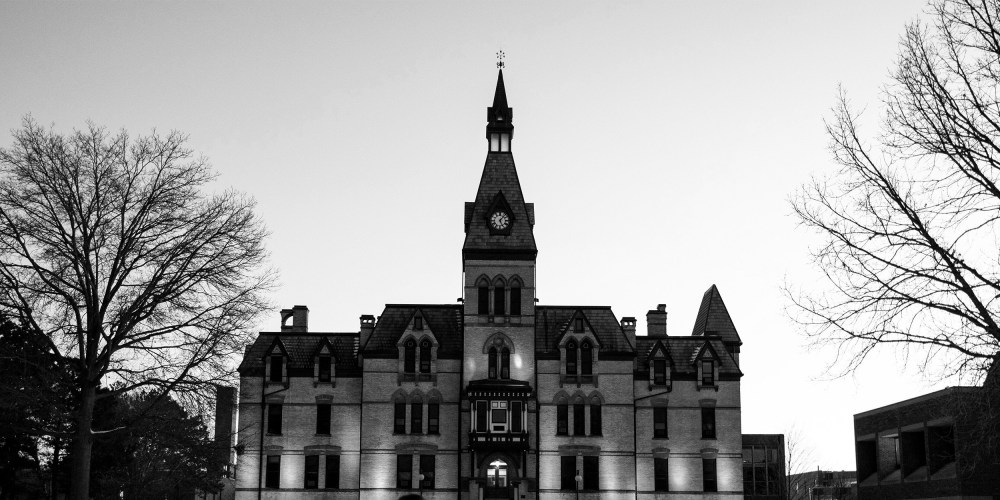The recent controversy surrounding a Hamline University art history professor who showed her class a medieval image of the Prophet Muhammad has many on the right bemoaning the “woke mob” run amok. I, by contrast, view this episode as evidence of the collapse of the American professoriate from within its own ranks, so to speak. We, the professors, have met the enemy. In many instances, as I’ll explain below, the enemy is us.
Let’s start with the dismal specifics of the case. Dr. Erika López Prater received her doctorate in 2019. Last fall, she taught a “World Art” class at Hamline. Her syllabus listed images of sacred subjects, such as the Buddha and the Prophet Muhammad. One of the two visual texts of the prophet she selected was “A Compendium of Chronicles,” attributed to Rashid-al-Din (1247-1318).
The academic rationale for including this work seems sound. One expert observed that this image of the prophet is a “masterpiece of Persian manuscript painting … an authentic and irreplaceable work of art.” López Prater has shared her own reasoning for showing the piece to her class: “I do not want to present the art of Islam as something that is monolithic.”
If there’s a pedagogical “best practice” that López Prater missed, I don’t know what it is.
In some quarters of the Muslim world, iconic representations of the prophet are prohibited. As the Jyllands Posten and Charlie Hebdo tragedies indicate, the display of such images risks offending sensitivities and even sparking violence. Aware of this, conscientious scholars proceed with discretion.
The precautions López Prater took to spare her students discomfort are chronicled in a fine article by Amna Khalid, a historian at Carleton College. The syllabus encouraged students to reach out if they had concerns. The analysis she assigned about the images was optional. Before they were presented on screen, she let students log out of the online session. I teach courses on blasphemous art, triggering literature and controversial comedy — if there’s a pedagogical “best practice” that López Prater missed, I do not know what it is.
Class went off seemingly without a hitch, but later one student complained. The professor shared the complaint with her chair and they co-wrote an apology. The video of the lesson somehow got “out there,” outside of the private confines of a classroom (a breach of academic convention I worried about when the Covid lockdown exiled us to Zoom). Soon, outside actors like the Council on American-Islamic Relations entered the fray, expressing concerns about Islamophobia.
The Hamline administration, led by President Fayneese Miller, Dean of Liberal Arts Marcela Khostihova and Vice President of Inclusive Excellence David Everett, swung into action. They weighed the possibility that a hate crime had been committed. When all was said and done, López Prater was not asked to teach at Hamline in the next semester. But her “adjunct” status (see below) could permit the university to plausibly claim that this had nothing to do with the controversy.

Spinning this episode as an example of “‘Libs gone wild” is misguided; as often happens with academic dust-ups, it doesn’t track along a neat left/right axis. The student who complained is president of the campus Muslim Students Association. In support of this student, Miller wrote: “It is not our intent to place blame; rather, it is our intent to note that in the classroom incident — where an image forbidden for Muslims to look upon was projected on a screen and left for many minutes — respect for the observant Muslim students in that classroom should have superseded academic freedom.”
Dubious logic aside, is this position a left-wing or right-wing stance? As Khalid pointed out, Muslims have different perspectives on the appropriateness of visual representations of the Prophet Muhammad. Hamline, Khalid continued, “privileged a most extreme and conservative Muslim point of view.” Did university administrators cave to the “woke mob,” or traditionalist religious mores? Couldn’t our Christian Right get behind more respect for Religious Authority in the classroom by that same logic?
The Hamline fiasco should not be analyzed in terms of cultural politics, but distressed job markets: the American professoriate is experiencing a prolonged and likely irreversible collapse. There are plenty of teaching jobs in colleges and universities. The problem is that the overwhelming majority of the available jobs are terrible. They offer risible pay, sparse benefits, long hours, and very little security. Further, these positions do not support scholars to conduct research or share their expertise freely in class.
The remaining good jobs are the ones with “tenure.” Professors on this track get an opportunity to “climb the tenure ladder” during what is (usually) a six to seven-year probationary period. If they pass this grueling test, they are virtually guaranteed lifetime employment. Because of Congress’s largesse back in 1994, there is no mandatory retirement age for these scholars! And since you can’t fire a tenured professor without substantial cause, this job comes with robust academic freedom protections.












